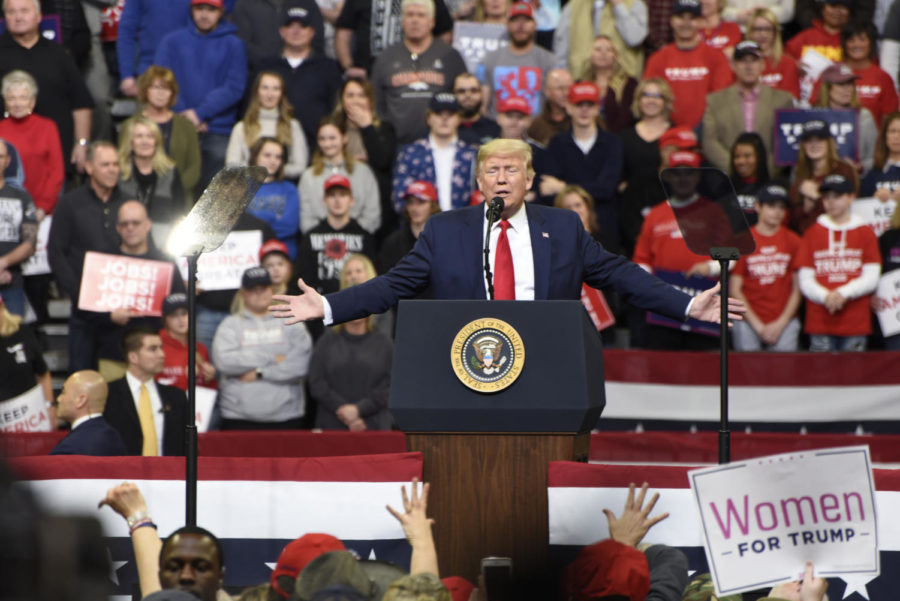Guest Column: Fallout from Trump’s trade war
February 2, 2020
President Trump’s tariff trade deployment with China started on Jan. 22, 2018, and a phase one trade agreement was reached on Dec. 13, 2019. Was this 23-month isolationist trade war experiment successful or not?
Since we live in an agriculture-laden state, let’s start with documentation for this entity. Despite the recent signing of the U.S.-China trade agreement, Morning Consult, a market research company that surveys 5,000 people on a daily basis, says confidence within the agriculture sector has fallen. Why would this occur when China agreed to purchase $32 billion of U.S. agriculture products and farmers received $28 billion in the form of a socialist-like bailout? First, confidence in Trump was lost when he favored oil companies over the biofuel industry. They know his trade war was the contributor to a 24 percent surge in farm bankruptcies in 2019 and have observed commodity prices not fluctuating one iota since the trade agreement. Finally, they are knowledgeable of Trump’s truth-telling persona.
Iowans recall Trump’s campaign promise that he — and he alone — would increase America’s Gross Domestic Product to 4 percent. With Trump’s trade war, the United States’ GDP has dropped to 2 percent, whereas China’s economic growth stands at 6 percent. If these rates continue, China’s economy will overtake the U.S. in 2030 and become the world’s number one economic power.
In down-to-earth terms, Trump’s trade war has caused each American family to pay $1,000 more during each of the past two years for the imported goods they purchased. Trump’s claim that China would pay the tariffs is false — U.S. companies pay the tariff, and the tariff is passed onto consumers.
The biggest failure of Trump’s recent deal with China is that it leaves tariffs in place on $370 billion or about 75 percent of Chinese imports to America. So, yes, you’ll continue to be paying more for products thanks to Trump’s “America First” policy.
It gets worse. The U.S.-China agreement does not address China’s cyber-theft behavior or China subsidizing their industrial sector. As the New York Times reported on Jan. 16, Trump’s “new deal between the United States and China leaves untouched the thorniest issues driving the two economic giants apart.”
International trade experts agree China’s promise to buy $200 billion in additional U.S. exports (e.g., grain, pork, industrial goods, etc.) during the next two years looks improbable. John Frisbie, a China trade expert at Hills and Co., said, “Overall uncertainty is not reduced much because there is no removal of existing tariffs.”
Administration officials within the White House also doubt if “phase two” will ever get done. China is showing no signs of dropping its retaliatory tariffs, the trade war has prompted China to redouble efforts to produce their own advanced technology and China’s “private and manufacturing sectors are in their best shape since mid-2018” (Wall Street Journal, Jan. 21).
Despite Trump’s promise that tariffs would attract more foreign investments in America, according to the administration’s own data, Foreign Direct Investment into the U.S. dropped by a record-breaking 45 percent. America’s share of global FDI declined for the first time in a decade and an unprecedented loss for the U.S. economy.
In a Jan. 10-12 Morning Consult/Politico poll, Trump’s three-year report card by voters gave him an overall grade of C- on international trade and a C-/D+ grade on foreign relations. Clearly, knowledgeable Americans know Trump’s claim to be the greatest deal maker ever is blatantly false and hyperbolic.
Trump’s band of supporters continue to defend his isolationist trade policy on shaky political grounds, but they’ve ignored the mounting evidence that trade wars cause needless economic harm, create unnecessary diplomatic consequences and insure unwarranted chaos.







